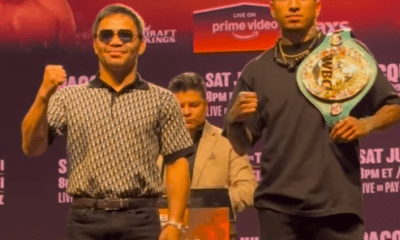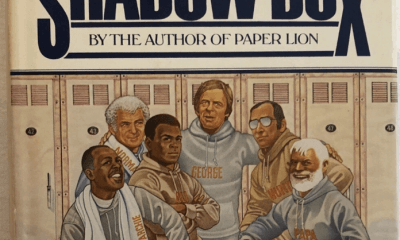Featured Articles
Hopkins Looking At Stevenson, Ward, Even Mayweather
 There is a dark cloud from the other side of the Atlantic Ocean that hovers like radioactive fallout over IBF light heavyweight champion Bernard Hopkins’ Oct. 26 defense against Germany’s Karo Murat in Atlantic City’s Boardwalk Hall.
There is a dark cloud from the other side of the Atlantic Ocean that hovers like radioactive fallout over IBF light heavyweight champion Bernard Hopkins’ Oct. 26 defense against Germany’s Karo Murat in Atlantic City’s Boardwalk Hall.
That dark cloud has a name: Morrade Hakkar.
Even with the emergence of highly credible European champions and contenders in multiple weight classes, those fighters tend to mostly ply their trade in and around their own countries, and off American TV. (Hopkins-Murat will be televised by Showtime Championship Boxing.) There is a lingering suspicion among more than a few U.S. boxing buffs that foreign fighters with whom they are generally unfamiliar – be they from Europe, Asia, South America or Africa – are somehow less worthy than homegrown Americans, despite mounting evidence to the contrary. And, let’s face it, Murat (25-1-1, 16 KOs) – who will be making his first professional appearance on these shores – is very much a mystery man, despite his No. 2 ranking from the IBF, to fight fans who will be in attendance in Boardwalk Hall or catching the action on Showtime.
No wonder there are those, including Hopkins (53-6-2, 32 KOs; seen above in Hogan photo) who are hoping, even praying, that the 31-year-old German is a vast upgrade over Hakkar, who furnished the opposition (well, sort of) for B-Hop’s only world title bout in his hometown of Philadelphia. That matchup, in which Hopkins successfully defended his IBF/WBC/WBA middleweight crowns on an eighth-round stoppage of an overmatched and clearly frightened Hakkar on March 29, 2003, in the since-demolished First Union Spectrum, was such a stink bomb that Larry Merchant’s post-fight interview with the winner began with him asking if Hopkins was “embarrassed” to have fought someone as inept as the French stiff.
“Why should I be embarrassed?” an indignant Hopkins responded. “I didn’t make the guy the No. 1 contender. (HBO) gave Roy Jones four years to fight school teachers and policemen. Roy can do it and I can’t? I’m asking to fight the best fighters. I’m 38. I’m so ancient, why aren’t the great, young fighters calling out the old man?”
If he truly felt that way, why didn’t Hopkins simply ditch one of his bejeweled championship belts, Merchant persisted, as Riddick Bowe once did, rather than to proceed with a mandatory that he felt was beneath him?
“To give up any of my belts would be like taking a shotgun and blowing my own foot off,” Hopkins explained. “If I’m not getting big fights with three belts, how am I going to get them if I give any of my belts away? I don’t see why I should be punished when (the world sanctioning bodies) continue to put guys (at No. 1) who ain’t supposed to be there. I’m not the problem.”
But there was a problem, according to HBO senior vice president Kery Davis, and one that boxing, or maybe Hopkins, needed to correct if it was to avoid what had just taken place in the ring when Hakkar did his impression of a fleeing thief being pursued by a satin-trunked cop.
“This was an embarrassing mismatch in terms of a mandatory,” Davis fumed. “This is why you hate mandatories. We wanted to get Bernard a bigger name, but this is the guy he wanted to fight.”
It should be noted that Karo Murat is Hopkins’ mandatory challenger. The IBF’s No. 1 contender, Polish-born, Chicago-based Andrzej Fonfara (24-2, 14 KOs), is coming off a ninth-round stoppage of Gabriel Campillo on Aug. 16, and thus was unavailable to jump in against Hopkins on such short notice. And, besides, is Fonfara any more of a household name in the U.S. than Murat?
Ten years after Morrade Hakkar and things would not appear to have changed much for the aging legend or for the fight game in general. Hopkins is now 48, the last of the padded-glove dinosaurs, still guarding the belt he said offers him a measure of protection against sinister guys in suits who would strip him of his relevancy, and still calling out the hot, young stars who could give him the big fights, big paydays and historic significance he says are necessary to keep him interested.
“If there was something more significant on the table, even without a title, sure, we could have rolled with that,” said Hopkins, the oldest man ever to have won a widely recognized world championship, a distinction he clearly cherishes. “I’ve done that before. I could vacate my title, say this guy (Murat) is not worthy, go for somebody with a bigger name. But there was nothing like that out there for me at this time. I can’t just sit around, close to 50, and not fight. So Golden Boy wants me to go ahead with this and keep my title, so we all decided to do it.
“Look, the light heavyweight division is heating up. I was watching when Adonis Stevenson (the WBC 175-pound champ) beat up Tavoris Cloud. Me and him would be a big fight. Me and (Sergey) Kovalev, too, or me and Andre Ward, even me and (Julio Cesar) Chavez Jr. You know Chavez can’t make 160 anymore, or even 168. (Gennady) Golovkin could come up and we could maybe do something at a catch weight.
“I’ll even throw another name out there that might sound crazy. If Floyd Mayweather is what he says he is, if he wants to come up in weight like Oscar did, I can come down and we can come to some sort of arrangement. I want to do something really big before I leave this game because that’s why I’m in the business. Yeah, I got the record for being the oldest world champion, and that’s nothing to sneeze at. But I want to go out with a fight as big as when I fought my friend and business partner, Oscar De La Hoya. I prefer superfights. I don’t want to fight mandatories. For what? Unless it’s a mandatory against somebody that everybody knows, a superstar like myself.”
To get to that megabucks finale, or maybe similarly important fights on the way to his big sendoff, Hopkins believes he needs to hold onto a title that is anything but worthless, no matter what some pundits insist. Maybe Mayweather is so monstrously important that he doesn’t need a belt to command public attention, but Hopkins, ever the conspiracy theorist, said that without one he is naked to the whims of behind-the-scenes types that have long sought to shuttle him off to the sideline where his big mouth would be effectively silenced.
“To get these guys to fight me I must hold my belt,” Hopkins said. “I got to hold the belt hostage. Because if I don’t, some of these guys are always going to choose a less dangerous champion to fight than Bernard Hopkins.”
Which brings us back to Karo Murat, the German who at least talks the talk. And maybe he is the unexpected rock slide that will derail Hopkins’ 25-year chug into boxing history.
“Bernard Hopkins is 48 years of age,” Murat said after the fight with Hopkins, which originally had been scheduled for July 13 at the Barclays Center in Brooklyn, N.Y., before it was delayed due to visa problems for Murat. “Will he be ready for me? I do not know. What I can say is that I will be my best on Oct. 26. When I am through messing up his old bones it will make me a star in an instant.”
So what does Hopkins think of Murat, who is making the familiar I’ll-kick-your-ass noises that everyone makes before the first bell rings?
“I can’t tell you s— about the guy, other than what I seen on YouTube,” Hopkins admitted. “Naazim (Richardson, Hopkins’ trainer) said he seen him once or twice when he was over there in Germany with Steve Cunningham.
“But, really, I’ve fought so many guys with so many different styles in my career, I can adapt and make whatever adjustments I need to make. And it’s not like I’m taking him light in any case. I’m preparing for him like he’s somebody that everybody knows because that’s the way I have to think. Fighters like this are tricky. You want people to come up to you on the street and say, `Man, that guy you’re fighting is good!’ You know they’d be saying that if I was fighting Adonis Stevenson or Andre Ward.
“I mean, the fact that he isn’t known much in the U.S. doesn’t mean he can’t fight. It’s just that you have to get as up mentally for someone who’s not known as you do for the guys everybody knows. I’ve always got my mind right for every fight, which is why I’ve stayed on top as long as I have. If I wasn’t like that, I could easily overlook this guy then, boom, he beats me because I didn’t bring my `A’ game.”
One wonders what would have happened to Hopkins had he gone to sleep on Hakkar, whom he probably could have defeated even if he had brought only his `D’ game.
“I once fought a guy like this from France – uh, what’s his name again? – who literally ran around the ring all night. A horrible fight. I won, I stopped him, but it was horrible.
“This guy (Murat) is way better than the French guy, but the situation is sort of similar. I know (Murat) got knocked out by Nathan Cleverly, and I’ve got that fight on DVD, but to be honest, I stopped watching it.
“Is he fundamentally sound? Yeah. He basically comes straight forward, hands up, tries to outwork you. He’s got that European style, doesn’t do anything fancy. So, yeah, the burden is on me to perform. I’m carrying all the weight for this fight, even in the promotion of it.
“There are a lot of possible distractions, but I know what I got to do, and I’m gonna do it.”
-

 Featured Articles3 weeks ago
Featured Articles3 weeks agoAvila Perspective, Chap. 330: Matchroom in New York plus the Latest on Canelo-Crawford
-

 Featured Articles2 weeks ago
Featured Articles2 weeks agoVito Mielnicki Jr Whitewashes Kamil Gardzielik Before the Home Folks in Newark
-

 Featured Articles4 weeks ago
Featured Articles4 weeks agoAvila Perspective, Chap 329: Pacquiao is Back, Fabio in England and More
-

 Featured Articles3 weeks ago
Featured Articles3 weeks agoOpetaia and Nakatani Crush Overmatched Foes, Capping Off a Wild Boxing Weekend
-

 Featured Articles2 weeks ago
Featured Articles2 weeks agoCatching Up with Clay Moyle Who Talks About His Massive Collection of Boxing Books
-

 Featured Articles4 weeks ago
Featured Articles4 weeks agoFabio Wardley Comes from Behind to KO Justis Huni
-

 Featured Articles1 week ago
Featured Articles1 week agoMore Medals for Hawaii’s Patricio Family at the USA Boxing Summer Festival
-

 Featured Articles4 weeks ago
Featured Articles4 weeks agoDelving into ‘Hoopla’ with Notes on Books by George Plimpton and Joyce Carol Oates















